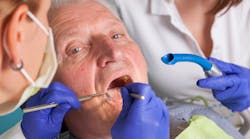Navigating dental care for patients with dementia
Many of us are not trained to care for patients with dementia besides a very general special needs course in dental hygiene school. This may not have been a concern before, but with more than nine million Americans living with some form of dementia,1 health-care providers need to gain a better understanding of the disease and how to care for those who suffer with it.
According to the Alzheimer's Association, the number of people in the US with Alzheimer's disease (a form of dementia) is expected to nearly double by 2025,2 so we’ll be seeing an increasing number of these patients in health-care facilities, including dental practices.
Dementia is the loss of cognitive function—the ability to think, remember, or reason—to such an extent that it interferes with a person's daily life and activities. These functions include memory, language skills, visual perception, problem solving, self-management, and the ability to focus and pay attention.3
Based on that description it’s clear that even tough patients living with dementia likely need dental care more than the average person (memory impairment can cause them to forget to brush their teeth). A dental visit can be quite challenging for them, (compromised language skills can make it difficult to communicate, for instance).
I’ve had the privilege of working with the nonprofit organization Second Wind Dreams based in Georgia that’s been training health-care workers for 25 years to provide empathetic, patient-centered care to dementia patients. I experienced a simulation that gave me a glimpse into the world of a person living with dementia and what I discovered was profoundly eye-opening. Here’s what you can do to make a dental or hospital visit more comfortable for a patient and less stressful for all parties involved.
Environment
- Reduce environmental stimuli by limiting background noise and activity. You can do this by selecting a quiet private area of the office. Turn off the TV if there’s one in the operatory.
- Play calming music or offer noise-canceling headphones to mute sounds of dental instruments, including those coming from other operatories.
- Keep the patient with the same providers when feasible since familiar faces and objects ensure patient comfort and compliance.
Scheduling
- Opt for early appointments, when patients are rested.
- Keep appointments short, when possible (60 minutes or under).
- Communicate with the caregiver to determine what time is best for the patient.
Verbal communication
- Approach from the front and at the same level as the patient so as not to startle them. Avoid speaking when you are out of sight as that might confuse them.
- Use short words or phrases and simple sentences. Break directions down into easy steps. For example, don’t say “Today we will take some radiographs, perform a periodontal evaluation and a periodic exam, as well as a periodontal maintenance.” Instead, say “I’ll clean your teeth.” “Open your mouth please.” And so on.
- If your message doesn’t get across right away, repeat exactly what you said; do not paraphrase.
- Speak slowly and clearly.
- Ask one question at a time and wait for a response.
- Ask closed yes or no questions as opposed to open-ended questions. “Do you brush every morning?” not “How often do you brush?”
- Remain patient if they ask you to repeat your request or if they ask the same questions.
- Do not correct or argue. For instance, if the patient claims they need to go to school later, go along with that even when you are certain they do not attend a school.
- Do not persist if the patient gets agitated. Seek assistance from the caregiver if needed.
Nonverbal communication
- Make direct eye contact and smile. Use a clear face mask if available. If not, exaggerate your expressions while wearing a mask.
- Make sure your movements are slow and use a gentle touch as a sign of reassurance.
- Demonstrate what you are instructing patients to do (the “watch me’” method). For instance, if you tell them to turn to the right, you can turn your head to show how to do it.
- Use the tell-show-do method: Tell the patient what you’re going to do and talk about each step before you do it. Show them how you’re going to do each step. Do the steps in the same way you've explained to them.
- Monitor facial expressions for discomfort or distress.
- Do not leave the patient unattended. They suddenly may not remember where they are, and that can be confusing and frightening.
Home care
- Talk to the caregiver about appropriate home care tools: a brush with a long or angled handle might be easier to use.
- Electric brushes may be confusing to patients with dementia.
- Flossing with traditional floss is likely challenging so interdental tools, such as proxabrushes or a water flosser, might work better.
- Advise caregivers to use gauze to wipe soft tissues and teeth if brushing doesn’t work.
- Stress the importance of removing dentures at night and rinsing them.
Following these tips will ensure a positive experience for patients living with dementia, as well as for providers. Person-centered care means we always treat individuals uniquely, with respect, and with dignity to the end of their lives. These are the keys to an optimal quality of life and a future filled with kindness and compassion.
References
1. Dementia Society of America. Dementia Society. Accessed July 29, 2024. https://www.dementiasociety.org/
2. Alzheimer’s disease facts and figures. Alzheimer’s. Accessed July 29, 2024. https://www.alz.org/alzheimers-dementia/facts-figures
3. Dementias. National Institute of Neurological Disorders and Stroke. U.S. Department of Health and Human Services. Accessed July 29, 2024. https://www.ninds.nih.gov/health-information/disorders/dementias#toc-the-basics-of-dementia-and-cognitive-impairment
About the Author

Anastassia Stoenelova, BA, RDH
Anastassia Stoenelova, BA, RDH, has been in dentistry for 10 years. She is a clinical practitioner in general dental practices in Atlanta, Georgia. As a former ESL instructor, she is passionate about oral health education and making a difference in her patients’ lives every day. She also works with Second Wind Dreams, a nonprofit organization that educates health-care professionals about dementia. She can be reached at [email protected].


